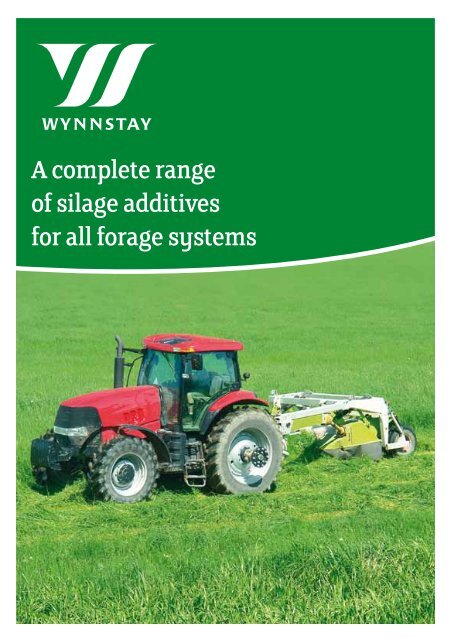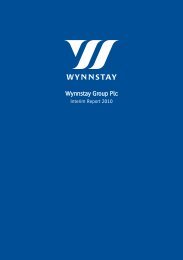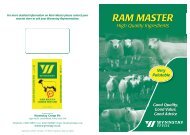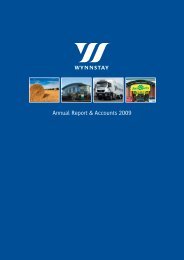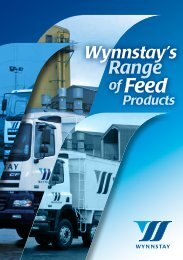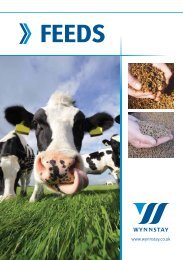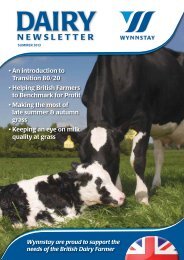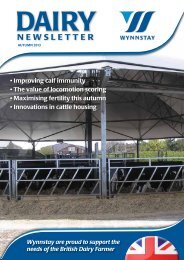of silage additives for all forage systems
download our Silage Additives Booklet - Wynnstay
download our Silage Additives Booklet - Wynnstay
- No tags were found...
Create successful ePaper yourself
Turn your PDF publications into a flip-book with our unique Google optimized e-Paper software.
A complete range<br />
<strong>of</strong> <strong>silage</strong> <strong>additives</strong><br />
<strong>for</strong> <strong>all</strong> <strong>for</strong>age <strong>systems</strong>
WYNNSTAY The Complete Range <strong>of</strong> Silage Additives<br />
The Wynnstay range <strong>of</strong> <strong>additives</strong> is designed specific<strong>all</strong>y <strong>for</strong> UK<br />
conditions. The products are made to ensure a good fermentation<br />
while maintaining the nutritional quality <strong>of</strong> <strong>silage</strong>, whether it is<br />
clamp, big bale, maize or wholecrop. All the Wynnstay <strong>additives</strong><br />
have been thoroughly researched and independently tested.<br />
The unique strain <strong>of</strong> Lactobacillus Plantarum used in the Wynnstay range <strong>of</strong> <strong>additives</strong> grows<br />
well across a wide pH range. Once applied the bacteria quickly dominate the natur<strong>all</strong>y<br />
occurring bacterial population to ensure a fast and efficient fermentation, this keeps ammonia<br />
levels down and nutrient levels up.<br />
Why use an additive:<br />
Although the <strong>silage</strong> making process can be explained very simply, it is actu<strong>all</strong>y very complex<br />
and dependant on many factors, such as the natural microbial population, harvesting<br />
conditions and the sugar content <strong>of</strong> the grass. Consequently, <strong>silage</strong> quality can be very variable<br />
and the only way to effectively control the fermentation process is to use an additive. The array<br />
<strong>of</strong> <strong>additives</strong> available can be very confusing so a straight <strong>for</strong>ward range has been developed<br />
where dry matter and type <strong>of</strong> crop determine the additive recommended.<br />
Cost Benefit <strong>of</strong> using an additive:<br />
Trials at Wye College demonstrated that cows fed grass <strong>silage</strong> treated with our additive yielded<br />
an extra 19 litres <strong>of</strong> milk per tonne <strong>of</strong> <strong>silage</strong> fed compared with those fed untreated <strong>silage</strong>. This<br />
equates to more than one litre <strong>of</strong> extra milk per cow per day. Giving an investment return <strong>of</strong> 4:1.<br />
32% increase in<br />
liveweight gain
WYNNSTAY XL40<br />
FOR GRASS SILAGE<br />
Wynnstay XL40 – An Ultra<br />
Low Volume biological<br />
inoculant <strong>for</strong> grass <strong>silage</strong>.<br />
Wynnstay XL40 delivers 1million lactic acid<br />
producing bacteria to every gram <strong>of</strong> <strong>for</strong>age<br />
with an application rate <strong>of</strong> 40ml per tonne <strong>of</strong><br />
<strong>for</strong>age, to aid a more efficient fermentation.<br />
Application<br />
Wynnstay XL40 can be applied at 40ml per<br />
tonne <strong>of</strong> <strong>for</strong>age or alternatively can be mixed<br />
at a lower concentration so that it can be<br />
applied at 200ml per tonne <strong>of</strong> <strong>for</strong>age.<br />
Benefits <strong>of</strong> Wynnstay XL40<br />
All the benefits <strong>of</strong> Wynnstay Clamp but with<br />
reduced down time because one applicator fill<br />
can last <strong>all</strong> day.<br />
• 32% increase in liveweight gain<br />
• 30% reduction in effluent<br />
• Intakes improved by 5%<br />
• 28% more protein retained<br />
• Improved milk production efficiency<br />
Cows yielded an extra 19 litres <strong>of</strong> milk per<br />
tonne <strong>of</strong> <strong>silage</strong> fed compared with those fed<br />
untreated <strong>silage</strong>.
WYNNSTAY CLAMP<br />
A traditional biological inoculant <strong>for</strong> clamp <strong>silage</strong>.<br />
Wynnstay Clamp delivers one million lactic acid producing<br />
bacteria to every gram <strong>of</strong> grass treated, to produce an efficient<br />
fermentation.<br />
Better quality <strong>silage</strong> every time.<br />
The table shows the results <strong>of</strong> trials carried out at the Welsh Plant Breeding Station where<br />
untreated <strong>silage</strong> showed the results <strong>of</strong> a classic poor fermentation: high ammonia-N, high pH and<br />
low lactic acid, compared with Wynnstay Clamp treated <strong>silage</strong> which had fermented efficiently.<br />
Dry Matter (%)<br />
pH<br />
Ammonia - N ( %Total N )<br />
Crude Protein ( %)<br />
Lactic Acid ( % <strong>of</strong> DM)<br />
ME ( MJ/kg DM)<br />
WYNNSTAY CLAMP Treated<br />
21.7<br />
3.8<br />
4.0<br />
18.7<br />
7.8<br />
10.7<br />
Untreated<br />
19.4<br />
4.5<br />
10.4<br />
19.4<br />
2.5<br />
10.3<br />
28% more protein retained.<br />
As a result <strong>of</strong> more efficient fermentation, protein is protected from breakdown during ensiling.<br />
Trials at IGER demonstrated this: livestock digested 28% more <strong>of</strong> the protein in Wynnstay<br />
Clamp treated <strong>silage</strong> when compared to untreated <strong>silage</strong>,<br />
+4.4%<br />
Milk<br />
Yield<br />
+3.0%<br />
Milk<br />
Protein<br />
+6.8%<br />
Milk<br />
Protein<br />
Yield<br />
+4kg<br />
Liveweight<br />
Gain<br />
Improved milk production efficiency.<br />
Trials at Wye College illustrated improved per<strong>for</strong>mance <strong>of</strong> cows fed Wynnstay Clamp treated<br />
<strong>silage</strong>. The cows yielded an extra 19 litres <strong>of</strong> milk per tonne <strong>of</strong> <strong>silage</strong> fed compared with those<br />
fed untreated <strong>silage</strong>.
WYNNSTAY<br />
CLAMP<br />
FOR CLAMP SILAGE<br />
32% increase in<br />
liveweight gain.<br />
Wynnstay Clamp increased beef cattle<br />
liveweight gains by as much as 32% in work<br />
carried out at ADAS Liscombe, which amounted<br />
to an extra 19kg over the 99 day trial period. Feed<br />
conversion improved by 26% over animals<br />
fed untreated <strong>silage</strong>.<br />
32% increase in<br />
liveweight gain<br />
Intakes improved by 5%.<br />
All trial work has demonstrated the improved palatability <strong>of</strong> Wynnstay Clamp treated <strong>silage</strong><br />
with increased intakes and animal per<strong>for</strong>mance. Trials with beef cattle at Liscombe compared<br />
Wynnstay Clamp and two other leading <strong>silage</strong> <strong>additives</strong> with untreated <strong>silage</strong> and found that<br />
Wynnstay Clamp increased intakes by 5%.<br />
30% reduction in effluent.<br />
Kingshay found that Wynnstay Clamp reduced effluent by 30% compared with untreated<br />
<strong>silage</strong> and 55% compared with <strong>for</strong>mic acid treated <strong>silage</strong>.<br />
APPROVED TRIALS<br />
Improves liveweight gain<br />
Improves milk yield and quality<br />
Improves voluntary intakes<br />
Improves protein and energy utilisation<br />
Improves fermentation<br />
Reduces effluent
WYNNSTAY DOMINATOR<br />
A biological inoculant <strong>for</strong> 20 -30% DM <strong>silage</strong> wilted <strong>for</strong> 12 hours<br />
or more. Delivers 2 million lactic acid producing bacteria per gram<br />
<strong>of</strong> <strong>for</strong>age.<br />
Wilting <strong>for</strong> high dry matters.<br />
Wilting <strong>for</strong> 12 hours or more has become<br />
standard practice to reach the higher dry matters<br />
required by the modern dairy cow. However,<br />
longer wilting results in the proliferation <strong>of</strong><br />
spoilage organisms, such as coli<strong>for</strong>ms (see chart),<br />
leading to the loss <strong>of</strong> valuable nutrients.<br />
This means that a highly concentrated inoculant<br />
is now essential to out compete very high levels<br />
<strong>of</strong> spoilage organisms and reduce pH as quickly<br />
as possible.<br />
Even with good management techniques, over<br />
half <strong>of</strong> the true protein content <strong>of</strong> grass can be<br />
lost during the ensiling process if the pH is not<br />
reduced quickly enough.<br />
Effect <strong>of</strong> Wilting on Levels<br />
<strong>of</strong> Spoilage Organisms<br />
3,500,000<br />
3,000,000<br />
2,500,000<br />
2,000,000<br />
1,500,000<br />
1,000,000<br />
500,000<br />
0<br />
0 24 36<br />
Duration <strong>of</strong> wilt (hours)<br />
Highly concentrated <strong>for</strong>mulation.<br />
In response to these changing practices, Volac has developed Wynnstay Dominator – the most<br />
concentrated <strong>silage</strong> inoculant to be introduced to the market. Proven to out compete the higher<br />
levels <strong>of</strong> spoilage organisms present on wilted grass (see opposite), it consistently dominates the<br />
fermentation within the first 24 hours. Wynnstay Dominator will reduce the pH quickly,<br />
stabilising the <strong>silage</strong> and minimising the loss <strong>of</strong> valuable nutrients, such as protein and energy.<br />
Total domination <strong>of</strong> the clamp in 24 hours.<br />
Wynnstay Dominator was used in trials to treat 30% DM wilted grass <strong>silage</strong> with a high natural<br />
population <strong>of</strong> potential spoilage organisms. After ensiling <strong>for</strong> 17 hours, Wynnstay Dominator<br />
controlled the fermentation - 83% <strong>of</strong> the organisms present were lactic acid bacteria from<br />
Wynnstay Dominator, compared to only 55% when traditional additive was used - leading to a<br />
faster, more effective fermentation.<br />
Levels <strong>of</strong> potential<br />
spoilage organisms (cfu/g <strong>for</strong>age)
WYNNSTAY DOMINATOR<br />
FOR 20-30% DM SILAGE<br />
Domination <strong>of</strong> bacterial population 17 hours after inoculation<br />
comparing a traditional additive with Wynnstay Dominator.<br />
WYNNSTAY Dominator Additive<br />
Delivering 2 million bacteria per gram <strong>of</strong> <strong>for</strong>age.<br />
17%<br />
POTENTIAL<br />
SPOILAGE<br />
ORGANISMS<br />
83%<br />
LACTIC ACID<br />
BACTERIA FROM<br />
WYNNSTAY DOMINATOR<br />
Traditional additive<br />
Delivering 1 million bacteria<br />
per gram <strong>of</strong> <strong>for</strong>age.<br />
+ Increased Lactic Acid Bacteria<br />
= Greater domination <strong>of</strong> natural microbial population<br />
= Faster, more efficient fermentation<br />
= Up to an extra 19 litres milk per tonne <strong>of</strong> <strong>silage</strong> treated<br />
45%<br />
POTENTIAL<br />
SPOILAGE<br />
ORGANISMS<br />
55%<br />
LACTIC ACID<br />
BACTERIA FROM<br />
TRADITIONAL<br />
INOCULANT
WYNNSTAY HI-DRI<br />
A biological inoculant with natural microbial inhibitor <strong>for</strong> high DM<br />
and big bale grass <strong>silage</strong>.<br />
Delivers 2 million lactic acid producing bacteria per gram<br />
<strong>of</strong> <strong>for</strong>age.<br />
Wynnstay Hi-Dri is speci<strong>all</strong>y <strong>for</strong>mulated to improve the quality <strong>of</strong> high dry matter and big bale<br />
grass <strong>silage</strong> (e.g. haylage) and reduce the risk <strong>of</strong> aerobic spoilage.<br />
As well as delivering highly concentrated levels <strong>of</strong> Lactobacillus plantarum bacteria, Wynnstay<br />
Hi-Dri also contains the natural microbial inhibitor found in garlic, Alliin. They work together to<br />
give controlled fermentation with minimal protein breakdown and maintain a cool <strong>silage</strong> that is<br />
high in nutrient value.<br />
Improves fermentation.<br />
Trials at IGER compared Wynnstay Hi-Dri treated big bale <strong>silage</strong> with untreated clamp <strong>silage</strong>.<br />
The Wynnstay Hi-Dri treated bales showed a faster and more efficient drop in pH.<br />
Improves aerobic stability.<br />
The graph opposite shows the results <strong>of</strong> work carried out at CEDAR. Again Wynnstay Hi-Dri<br />
resulted in a more stable fermentation than untreated <strong>silage</strong>, with reduced heating, lower<br />
ammonia-N levels, higher lactic acid concentrations and significantly improved aerobic stability<br />
at feedout.<br />
Inhibits yeasts and moulds.<br />
Trials have consistently shown Wynnstay Hi-Dri’s unique <strong>for</strong>mulation helps to overcome the<br />
problems associated with aerobic stability, as well as producing a faster more stable<br />
fermentation.<br />
Improved animal per<strong>for</strong>mance.<br />
Cows fed Wynnstay Hi-Dri treated <strong>silage</strong> in trials at Wye College yielded an extra 19 litres per<br />
tonne <strong>of</strong> <strong>silage</strong> compared with those fed untreated <strong>silage</strong>. Trials at IGER demonstrated the<br />
significant advantages <strong>of</strong> Wynnstay Hi-Dri treatment, when it increased liveweight gain in beef<br />
cattle by 33%.<br />
APPROVED TRIALS<br />
Improves liveweight gain<br />
Improves milk yield and quality<br />
Improves voluntary intakes<br />
Improves protein and energy utilisation<br />
Improves fermentation<br />
• Improves aerobic stability<br />
Reduces effluent
WYNNSTAY HI-DRI<br />
FOR HIGH DM AND BIG BALE SILAGE<br />
Temperature ˚C<br />
37% DM GRASS<br />
30<br />
28<br />
26<br />
24<br />
22<br />
20<br />
0 2 4 6 8<br />
Days after opening<br />
UNTREATED<br />
WYNNSTAY HI-DRI
WYNNSTAY CORN<br />
A biological inoculant <strong>for</strong> maize and wholecrop <strong>silage</strong>.<br />
The preservation <strong>of</strong> maize <strong>silage</strong> is similar to that <strong>of</strong> grass <strong>silage</strong>, consisting <strong>of</strong> fermentation to<br />
produce lactic acid, resulting in a reduction in pH which preserves the crop and prevents the<br />
growth <strong>of</strong> spoilage organisms. Maize has a high dry matter (DM) which together with the high<br />
starch content <strong>of</strong> maize cobs gener<strong>all</strong>y ensures a rapid fermentation removing the need <strong>for</strong> a<br />
lactic acid bacteria inoculant to aid fermentation. The maize <strong>for</strong>age is at risk from aerobic<br />
spoilage due to its high DM and high starch so the use <strong>of</strong> an additive to prevent the growth and<br />
colonisation <strong>of</strong> yeasts and moulds during ensiling and feed out is essential. Wynnstay Corn has<br />
been proven to reduce the growth <strong>of</strong> these yeasts and moulds and there<strong>for</strong>e increases the<br />
aerobic stability <strong>of</strong> maize <strong>silage</strong> thus reducing the risk <strong>of</strong> heating at the clamp face.<br />
Tried and Tested.<br />
Trial work has been carried out comparing<br />
30% DM maize <strong>silage</strong> treated with Wynnstay<br />
Corn against untreated maize. The graph,<br />
right, shows the difference in stability on<br />
exposure to air 95 days after ensiling. Access<br />
to air encourages yeasts to multiply, but with<br />
treatment with Wynnstay Corn the time<br />
taken <strong>for</strong> concentrations to reach ‘at risk’<br />
levels is greatly extended there<strong>for</strong>e increasing<br />
the time available to feed the <strong>for</strong>age be<strong>for</strong>e the<br />
onset <strong>of</strong> nutritional losses.<br />
Yeast Concentration cfu/g<br />
Maize Aerobic Stability<br />
@ 95 Days<br />
Untreated<br />
Wynnstay Corn<br />
1,000,000,000<br />
100,000,000<br />
10,000,000<br />
2,000,000 DANGER: RISK OF AEROBIC SPOILAGE<br />
1,000,000<br />
100,000<br />
10,000<br />
0 3 5 7 10<br />
Days after opening<br />
Wholecrop.<br />
The popularity <strong>of</strong> ensiling wholecrop cereals<br />
has increased over recent years as they <strong>of</strong>fer<br />
a good alternative to traditional <strong>for</strong>ages. Cereal<br />
wholecrop can be high yielding and benefit<br />
from a wide harvest window <strong>all</strong>owing <strong>for</strong><br />
wholecrop to be harvested with varying dry<br />
matters. Due to this wide range in dry matters<br />
the extent <strong>of</strong> fermentation will vary. These<br />
crops are at risk from aerobic spoilage and<br />
heating in the clamp. It is there<strong>for</strong>e<br />
recommended that when using an inoculant,<br />
a brand incorporating an aerobic spoilage<br />
inhibitor such as Wynnstay Corn is applied.
CORN<br />
FOR WHOLECROP AND MAIZE SILAGE<br />
Fermented Wholecrop<br />
(35 - 55% DM).<br />
The use <strong>of</strong> Wynnstay Corn has been proven to<br />
dramatic<strong>all</strong>y improve aerobic stability. Applied<br />
at 2 litres per tonne fresh weight, the graph<br />
compares 40% DM wholecrop treated with<br />
Wynnstay Corn against untreated wholecrop.<br />
After 48 hours exposure to air, spoilage yeasts are<br />
7000 times more concentrated on the untreated<br />
wholecrop, increasing the risk <strong>of</strong> nutrient losses<br />
in the clamp due to aerobic spoilage.<br />
High DM Wholecrop<br />
(56 - 75%DM).<br />
Due to high grain maturity, wholecrop <strong>of</strong> this dry<br />
matter should be harvested using a primary<br />
processing mill to ensure maximum digestion<br />
when <strong>for</strong>age is fed. Due to the high DM, limited<br />
fermentation will occur. However aerobic<br />
spoilage can occur causing heating and nutrient<br />
loss. The graph, right, shows 72% DM wholecrop<br />
four months post harvest. Treatment <strong>of</strong> the crop<br />
with four litres per tonne <strong>of</strong> Wynnstay Corn at<br />
harvest ensures better aerobic stability when<br />
exposed to air.<br />
Yeast Concentration cfu/g<br />
Yeast Concentration cfu/g<br />
40% DM Wholecrop Aerobic<br />
Stability @ 17 Days Untreated<br />
Wynnstay Corn<br />
1,000,000,000<br />
100,000,000<br />
10,000,000<br />
2,000,000 DANGER: RISK OF AEROBIC SPOILAGE<br />
1,000,000<br />
100,000<br />
10,000<br />
0 2 4 7 11<br />
Days after opening<br />
72% DM Wholecrop Aerobic<br />
Stability @ 4 Months<br />
Untreated<br />
Wynnstay Corn<br />
100,000,000<br />
10,000,000<br />
2,000,000 DANGER: RISK OF AEROBIC SPOILAGE<br />
1,000,000<br />
100,000<br />
10,000<br />
1000<br />
100<br />
0 2 4 12<br />
Days after opening
CLAMP XL40 DOMINATOR HI-DRI CORN<br />
Crop Type/Dry Matter<br />
Grass 18%-25%<br />
Grass 18%-25%<br />
Grass Silage 20%-30%<br />
Wilted <strong>for</strong> 12+ hours<br />
Grass 30+%<br />
Big Bale 30+%<br />
Haylage 55%-70%<br />
Maize 30%-35%<br />
Whole Crop 35%-75%<br />
Ingredients per Gram<br />
<strong>of</strong> Forage Treated<br />
1x10 6 Lactobacillus plantarum<br />
1x10 5 Pediococcus pentosaceus<br />
1x10 6 Lactobacillus plantarum<br />
1x10 5 Pediococcus pentosaceus<br />
2x10 6 Lactobacillus plantarum<br />
Stimulant package<br />
2x10 6 Lactobacillus plantarum<br />
Alliin, natural microbial<br />
inhibitor<br />
Lactobacillus bacterium<br />
Alliin, natural microbial<br />
inhibitor<br />
Application Feature<br />
Liquid<br />
(instant - ready to use)<br />
Liquid only<br />
(instant - ready to use)<br />
Liquid only<br />
(instant - ready to use)<br />
Liquid only<br />
(instant - ready to use)<br />
Liquid only<br />
(instant - ready to use)<br />
Special Features<br />
- Reduces effluent by 30%<br />
- Reduces protein breakdown<br />
by 32%<br />
- Improves intakes by 5%<br />
- Extra 19 litres milk per tonne<br />
<strong>of</strong> <strong>for</strong>age treated<br />
- Reduces effluent by 30%<br />
- Reduces protein breakdown<br />
by 32%<br />
- Improves intakes by 5%<br />
- Extra 19 litres milk per tonne<br />
<strong>of</strong> <strong>for</strong>age treated<br />
- Flexible application rate<br />
- Improves fermentation<br />
efficiency<br />
- Total domination <strong>of</strong> the<br />
natural microbial population<br />
in 24 hours<br />
- Out-competes high levels <strong>of</strong><br />
spoilage organisms found on<br />
wilted <strong>silage</strong><br />
- Very rapid pH drop<br />
- Minimises protein breakdown<br />
- High quality <strong>silage</strong> produced<br />
- Alliin, natural microbial<br />
inhibitor<br />
- Improves aerobic stability<br />
- Reduces heating<br />
- Reduces yeast & mould levels<br />
- Alliin, natural microbial<br />
inhibitor<br />
- Improves aerobic stability<br />
- Reduces nutrient losses at<br />
feed out<br />
- Immediate and long lasting<br />
protection against spoilage<br />
Organic Approval<br />
Yes<br />
Yes<br />
Yes<br />
Yes<br />
Yes<br />
Storage<br />


